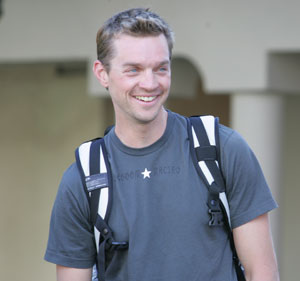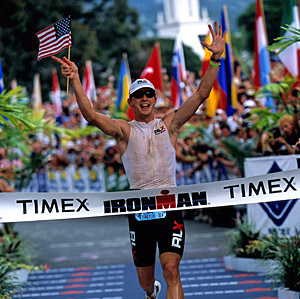Part 4: Tim DeBoom at 37, same age as Lance, tries the CTS route

What led DeBoom to seek a coach?
Tim DeBoom: The last few years as I bumped in and out of rehab it got to the point this year I didn’t even think about getting a coach. I had a plan in place. It was a little different because I know I have to change things. As I get older the body is not going to respond unless I change my training. The body needs new stresses, a new environment.
But when Lance Armstrong came back, that caught my attention, age-wise. (They are both 37) Working with Lance, I knew Chris (Carmichael, CEO of Carmichael Training Systems) was going to have a lot of positive information about recovery and rest. Training is still going to be the easy part, but I knew I need to learn how the body recovers and how much rest is needed.
When you are still guessing what to do it creates mental stress. When I saw Chris was in Kona with Lance, it kinda sold me on it right there. I knew definitely he had things which could help me with cycling and running. And I was at the point I had nothing to prove and nothing to lose. And my motivation is higher than ever. I was seeking to try new things, and I thought Chris could help me make lot of changes this year.
Priority One: Avoid injury and overtraining.
Kirk Nordgren; I think he just at a point in his career he has had some success, just being self coached but now is a time he wants confidence when out there training that he is doing the right thing. He does not want to worry what he does next day and what he does today is correct or not. He is not 25 or 30 any more. But he has such a history, as does Lance, of data while training at a high level. In Tim’s case, it is not like he did nothing last year. He trained for a 100 mile run race. He comes to us in very good condition. Like any athlete you want to make sure they are not doing too much. There are markers we want to keep close track of on a daily basis. Can he produce the power in the workout he should be producing? If he is not able to do that or able to do it with the advantage of getting daily feedback from somebody. It’s not all numbers. There has to be a coach-athlete relationship that allows us to push them to edge without injury or overuse setbacks.
Now when he had some of those races, he is a different athlete at a different point in his career. He does not want not replicate all that was done 7-8 years ago. His goal is not to replicate what he did to get that initial success. He can’t do that again. The goal is to get the best out of him now.
DeBoom likes his start with CTS
TD: So far I have been impressed what they do with me. It all comes down to communication. I give them feedback. I trust them and like it but if something won’t work, I have no problems speaking up about it. I have never really been coached in triathlon before. I do not consider myself easy to coach. I ask why. But I'm not temperamentally opposed. I've probably had some tough swim coaches over the years. But it definitely will be a change.
DeBoom faced a big change switching from training by feel to use high tech data.
TD: One of my biggest changes is training with data. Yes I’ve had all the tools but I’ve never put them to real use. I’ve used them as toys but I have not systematically gathered data on my body and kept notes. The only data I used was blood work to make sure I was healthy enough to train. Now I use a power meter and constantly wear a heart monitor which shows me when I'm getting fitter and when I need rest.
KN: Tim has not used the power meter because he did not know how to apply the information he got into a consistent program. One thing will definitely benefit him. We will take him to the wind tunnel and use our vast companywide expertise to help him adopt the most efficient aerodynamic position. Daily we will get his power readings from his bike rides and pacing data with a Garmin GPS from all his runs. With that data in hand, we will bring him back to obtain physiological data to chart his improvements.
TD: I find the training data useful. But I do not plan to race Kona with a heart rate monitor. to hold me back. In the past, I feel the mileage was there, but I haven’t trained hard enough intensity-wise on a consistent basis. Back in 1999, my first huge improvement came when I learned how to rest back. Now I think I’m learning to up the intensity a little more.
DeBoom feels a lot of the mishaps of the past few years were caused by little things
TD: A lot it was little things. Not training mistakes by any means. But if bike fit is off by a little you can have a 3-4 month injury detour. And if the bike fit is off, the run form is off, that causes injury. I am not concerned about intensity or volume of training. My body can handle it. When you don’t rest and form gets off, that is when you get injured.
Kirk Nordgren: Preventing injuries first priority
KN: A key point in the back of my mind are the injuries he has suffered the past few years. I think a big advantage for him will be to work with someone with an outside, bird’s eye view. We will let him know when it’s too much. Obviously those stress fractures are usually the result of overdoing it. One thing we are doing with Tim and what we do with everybody is to not push to a level that will get the athlete injured.
He is coming into this year with a really good place. He took a year off and did not have a major overuse injury. He was going to do the Leadville 100 mile run and just bruised his foot. I guess that thing was an acute injury, not a chronic injury. So I think he is in a really good place physically and mentally from that time off. And running for Leadville gave Tim a greater base.
The advantages? He obviously has a great base of run miles he developed last year. I feel comfortable with his running stride and running base coming into 2009. He says he has more of a base in running at this time of year than in years past. He was running a lot, even more than I’d have liked. But he did get injured in a way that wasn’t from overuse. All that is good, we have confidence he can handle the necessary workload quite well.
The first target is the bike
KN: One of the first things we did was bring him down to the Colorado Springs office for physiological testing – lactate threshold and VO2 max on the bike. The difference using a cycling meter instead of treadmill is that cycling you use slightly less VO2 max, and there is less muscle activation. The goal is to work on raising his lactate threshold power on the bike.
Strategy: Load Tim up to the magic point, not under not over
KN: The trick that we know how to essentially overload Tim’s different energy systems to let him recover from that and in a structured way so he does come peaked and ready to race well. We certainly use power meter readings to look at his daily workouts to determine whether he needs more work at a certain level or is getting tired and needs to back off.
This year our goal is certainly not win the bike leg. There is nothing magical about that. Just to improve his power on the bike so he can put in a better split and is still fresh for the run. Last year, Craig worked a lot on his power on the bike. He put in a very competitive split but did not exert too much to hurt his running



